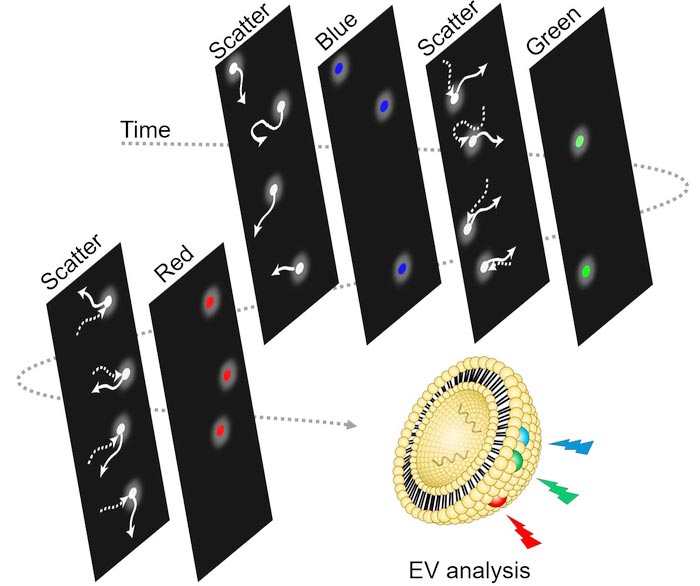Tracking the movement of a single nanoparticle

Fluorescence-based analysis of extracellular vesicles by time-sequential illumination and tracking
Credit: POSTECH
Based on the principle of interaction between matter and light, a new method has been developed to track and observe the Brownian motion of fast-moving nanometer-sized molecules, and measure the different fluorescence signals of each biological nanoparticle.
The nanoparticle tracking analysis (NTA) system is the most commonly used nanoparticle quantification method in the world. It is a method that observes and tracks a group of nanoparticles in a captured image as a single particle unit. Recently, a POSTECH research team – led by Dr. Siwoo Cho and Ph.D. candidate Johan Yi of the Department of Mechanical Engineering – succeeded in measuring the number, size, and brightness of scattered light through NTA and further measured the different fluorescence signals of individual particles.
The research team developed a fluorescence-based nanoparticle tracking analysis (NTA) system to characterize the size and protein expression of individual extracellular vesicles (EV). In this system, a sheet of lasers with four different wavelengths was shone onto the EVs according to a programmed schedule, providing scattering images intercalated by three fluorescent images. The size, ratio, and scattered light of thousands of individual particles were observed, and a six-dimensional value composed of three different fluorescence was obtained.
Using this proposed NTA system, the researchers measured the distribution of specific proteins in EVs (e.g., exosomes), which are biological nanoparticles, at individual particle levels and analyzed the relationship between the proteins.
This NTA system enables the user to observe the nanoparticles during analysis and obtain quantitative data of individual or all nanoparticles immediately after loading the sample without a needing a control group. It allows the researchers to observe cells at the molecular level to obtain important clues to understanding various life processes.
For example, since the system targets all types of nanoparticles, it can be used for environmental monitoring such as fine dust, bio-nanoparticle analysis for virus research and development, and disease diagnosis and bio-monitoring through nanoparticle analysis of various body fluids.
“The multiplex fluorescence-based NTA system developed in this study enables scientists to analyze the association between different proteins in exosomes,” explained Professor Jaesung Park of POSTECH. “We expect it to contribute significantly to the advancement of industries and research related to exosomes in the future.”
The research team received technical support, equipment, and experiment materials from ExosomePlus, Inc. and is awaiting commercial release through this research collaboration.
Supported by the ICT Convergence Research Center’s Mid-Career Research Program and the Korea Medical Device Development Fund funded by multiple ministries of Korea, this study was published in ACS Nano on June 23, 2021.
Journal
ACS Nano
DOI
10.1021/acsnano.1c02556
Article Title
Multifluorescence Single Extracellular Vesicle Analysis by Time-Sequential Illumination and Tracking
Article Publication Date
22-Jun-2021
Media Contact
Jinyoung Huh
jyhuh@postech.ac.kr
Office: 82-54-279-2415
All latest news from the category: Life Sciences and Chemistry
Articles and reports from the Life Sciences and chemistry area deal with applied and basic research into modern biology, chemistry and human medicine.
Valuable information can be found on a range of life sciences fields including bacteriology, biochemistry, bionics, bioinformatics, biophysics, biotechnology, genetics, geobotany, human biology, marine biology, microbiology, molecular biology, cellular biology, zoology, bioinorganic chemistry, microchemistry and environmental chemistry.
Newest articles

Pinpointing hydrogen isotopes in titanium hydride nanofilms
Although it is the smallest and lightest atom, hydrogen can have a big impact by infiltrating other materials and affecting their properties, such as superconductivity and metal-insulator-transitions. Now, researchers from…

A new way of entangling light and sound
For a wide variety of emerging quantum technologies, such as secure quantum communications and quantum computing, quantum entanglement is a prerequisite. Scientists at the Max-Planck-Institute for the Science of Light…

Telescope for NASA’s Roman Mission complete, delivered to Goddard
NASA’s Nancy Grace Roman Space Telescope is one giant step closer to unlocking the mysteries of the universe. The mission has now received its final major delivery: the Optical Telescope…



